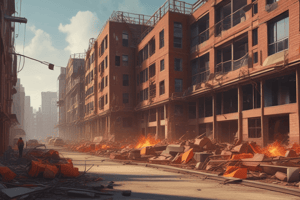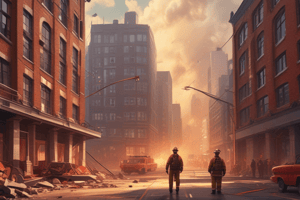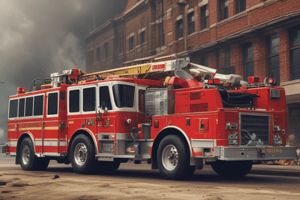Podcast
Questions and Answers
The toll from collapses is likely to continue, if not increase, due to changes in the methods of construction that place a greater value on _____ materials and lower ____ than on lives of FFs and occupants when those materials are exposed to fire
The toll from collapses is likely to continue, if not increase, due to changes in the methods of construction that place a greater value on _____ materials and lower ____ than on lives of FFs and occupants when those materials are exposed to fire
Lightweight cost
Buildings that have the greatest resistance to collapse are those of class 1 ____ construction. These buildings have fire resistance ratings of up to _ hours
Buildings that have the greatest resistance to collapse are those of class 1 ____ construction. These buildings have fire resistance ratings of up to _ hours
Fireproof 4
The floor support beams of the one meridian plaza in Philadelphia had only _ hour rates sprayed on fireproofing and still they endured nearly __ hours of fire exposure
The floor support beams of the one meridian plaza in Philadelphia had only _ hour rates sprayed on fireproofing and still they endured nearly __ hours of fire exposure
2 11
As discussed in ch 18 the most severe collapse danger in class 1 buildings occurs poured in place concrete buildings under construction when fire involves the ____ ____ of the most recently poured floor
As discussed in ch 18 the most severe collapse danger in class 1 buildings occurs poured in place concrete buildings under construction when fire involves the ____ ____ of the most recently poured floor
The second best construction type as far as resistance to collapse is concerned is ____ ____ construction class _
The second best construction type as far as resistance to collapse is concerned is ____ ____ construction class _
Pg 545 says that they are generally quite stable due to the size of their load bearing members, which are generally x wooden columns and ___ walls. Pg 26 ch 2 says x
Pg 545 says that they are generally quite stable due to the size of their load bearing members, which are generally x wooden columns and ___ walls. Pg 26 ch 2 says x
An increasingly common exception to being run out before collapse of class 4 is if it has had numerous repeated fires in the same area, usually in old _____ buildings that have been abandoned by their former owners
An increasingly common exception to being run out before collapse of class 4 is if it has had numerous repeated fires in the same area, usually in old _____ buildings that have been abandoned by their former owners
Collapses in class 4 buildings are often large scale ones, with both ___ and ___ being affected. At advanced fires in these structures apparatus should be removed from the ___ ____
Collapses in class 4 buildings are often large scale ones, with both ___ and ___ being affected. At advanced fires in these structures apparatus should be removed from the ___ ____
The third most collapse resistant building is that of class _ ordinary construction, or the standard brick and wood joist. These buildings are generally more prone to ___ ___ than collapse
The third most collapse resistant building is that of class _ ordinary construction, or the standard brick and wood joist. These buildings are generally more prone to ___ ___ than collapse
A distinct danger in class 3 is the imposition of unusually high ___ ___, such as may be found in a ____ supply warehouse and any concentrated loads, such as from roof mounted ___ ____ and ____
A distinct danger in class 3 is the imposition of unusually high ___ ___, such as may be found in a ____ supply warehouse and any concentrated loads, such as from roof mounted ___ ____ and ____
As with heavy timber buildings, imposition of ____ loads on walls from collapses of floors or roofs can cause ___ to fail
As with heavy timber buildings, imposition of ____ loads on walls from collapses of floors or roofs can cause ___ to fail
The fourth category in resistance to collapse is class _ (___ frame buildings)
The fourth category in resistance to collapse is class _ (___ frame buildings)
The standard wood frame home, built with ____ lumber is more likely to ___ through, chasing personnel out before it collapses. This only applies to standard construction methods and not those using lightweight ____ construction
The standard wood frame home, built with ____ lumber is more likely to ___ through, chasing personnel out before it collapses. This only applies to standard construction methods and not those using lightweight ____ construction
This leaves class _ construction (___ or __ ____) as the least resistant to collapse when exposed to fire. This is mainly due to large quantities of unprotected steel used in its construction
This leaves class _ construction (___ or __ ____) as the least resistant to collapse when exposed to fire. This is mainly due to large quantities of unprotected steel used in its construction
A __ ft long I beam heated _____ to 1,000 degrees will expand __ in lengthwise
A __ ft long I beam heated _____ to 1,000 degrees will expand __ in lengthwise
When steel is further heated to about ____ degrees it will lose about ___ its strength
When steel is further heated to about ____ degrees it will lose about ___ its strength
Those with protected steel or concrete supporting systems resist collapse rather well. These are called ____ structures, since most of their weight is carried on the ___ or ____. Collapses are usually very _____ only the area between supporting members
Those with protected steel or concrete supporting systems resist collapse rather well. These are called ____ structures, since most of their weight is carried on the ___ or ____. Collapses are usually very _____ only the area between supporting members
Structures that are built so that most of the weight rest on ____ ___ are known as _____ structures.
Structures that are built so that most of the weight rest on ____ ___ are known as _____ structures.
In all types of structures the failure of a ____ member such as a ___ or a ___ is usually more serious than that of a ____ member such as a beam since the column is more likely to support other members
In all types of structures the failure of a ____ member such as a ___ or a ___ is usually more serious than that of a ____ member such as a beam since the column is more likely to support other members
Which list the structural components in the correct hierarchy?
Which list the structural components in the correct hierarchy?
The ___ itself or the ____ may at times be the only indication that a collapse is likely.
The ___ itself or the ____ may at times be the only indication that a collapse is likely.
Flashcards
Lightweight Construction Risks
Lightweight Construction Risks
Modern construction prioritizes inexpensive materials, potentially reducing safety standards compared to older practices.
Class 1 Construction
Class 1 Construction
Class 1 buildings, made of fireproofed structural steel or concrete, offer the highest resistance to collapse, withstanding fire for up to 4 hours.
Concrete Building Collapse Danger
Concrete Building Collapse Danger
A building with wooden formwork may collapse if a fire involves the wooden formwork of the most recently poured floor.
Heavy Timber Construction (Class 4)
Heavy Timber Construction (Class 4)
Signup and view all the flashcards
Heavy Timber Dimensions
Heavy Timber Dimensions
Signup and view all the flashcards
Class 4 Collapse Risk
Class 4 Collapse Risk
Signup and view all the flashcards
Class 4 Collapse Zone
Class 4 Collapse Zone
Signup and view all the flashcards
Class 3 Construction
Class 3 Construction
Signup and view all the flashcards
Class 3 Load Risks
Class 3 Load Risks
Signup and view all the flashcards
Heavy Timber Wall Failure
Heavy Timber Wall Failure
Signup and view all the flashcards
Class 5 Resistance
Class 5 Resistance
Signup and view all the flashcards
Wood Frame Burn-Through
Wood Frame Burn-Through
Signup and view all the flashcards
Class 2 Construction
Class 2 Construction
Signup and view all the flashcards
I-Beam Expansion
I-Beam Expansion
Signup and view all the flashcards
Steel Strength Loss
Steel Strength Loss
Signup and view all the flashcards
Framed Structures
Framed Structures
Signup and view all the flashcards
Localized Collapses
Localized Collapses
Signup and view all the flashcards
Unframed Structures
Unframed Structures
Signup and view all the flashcards
Vertical vs Horizontal Failure
Vertical vs Horizontal Failure
Signup and view all the flashcards
Structural Hierarchy
Structural Hierarchy
Signup and view all the flashcards
Collapse Indicators
Collapse Indicators
Signup and view all the flashcards



